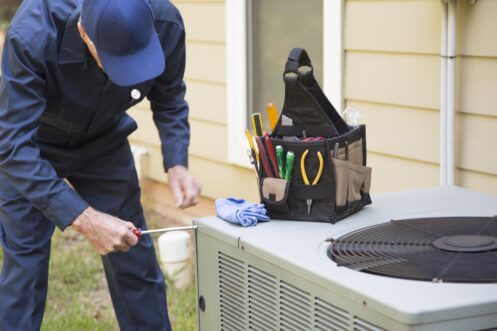As a property owner, it is easy to assume a bigger unit will quickly meet your home’s heating or cooling demands. Others may choose to purchase a smaller unit because of the lower cost. These choices often result in reduced comfort because an improperly sized HVAC system cannot deliver the desired temperature. That’s why you need to consult a professional technician to help you determine the proper unit for your home.
Exploring HVAC Sizing
The recommended size of an HVAC system is influenced by several factors that are added to a load calculation formula. When you call professionals to get a load calculation, they will add the following factors into a calculation tool:
Home Insulation and Air Infiltration
A home with poor insulation requires higher HVAC capacity because it allows a higher amount of heat entry and loss. Infiltration happens when outdoor air seeps into the house through gaps, cracks and openings. The rate of infiltration is determined by the air changes per hour and the difference between indoor and outdoor temperatures. Heat will also transfer through walls. As the R-value of your home insulation increases, the rate at which this heat transfer happens will lessen.
Windows
The size and number of windows in your home also affect the heating and cooling load. If your windows face the south or west, they may receive more direct sunlight. Your home may thus require more cooling because about 25 to 30% of the energy consumed by HVAC appliances is used to regulate heat gained or lost through windows. However, these same windows can help warm your home during the colder months.
Homes with energy-efficient windows may have lower heating and cooling loads. In colder climates, you can use gas-filled panes with low e-coatings for reduced heat loss or those with low U-factor because they have better thermal resistance. For warmer climates, you can use low solar gain coefficient (SHGC) or those with coating to reduce heat gain. In areas with cold and hot seasons, select windows with low U-factors and SHGC to minimize energy loss.
Climate
Homes in warmer regions may require higher cooling capacity, while those in colder regions need larger heating capacity. The temperature can fluctuate largely in some areas. A part load is added to the heating or cooling load so the system is well-sized to meet the variables. You can choose a single-stage HVAC system if you do not anticipate the weather to change rapidly and the temperature to rise or fall below the settings in your system. If there are times when the temperature in your area gets hotter or colder than the size of your system can control, it may be wiser to purchase a multi-stage unit.
Home Square Footage
The square footage of your home and the temperature range you desire to maintain throughout will determine the size of the HVAC unit you should buy. When considering the size of your house, include all the floors and ceilings to determine the required British Thermal Units (BTUs). This is the energy needed to heat or cool one pound of water by 1 Fahrenheit.
Ductwork Layout
The distance that HVAC-treated air must travel affects the power of the fan that you need to fully heat and cool the home. Homes with several floors or long layouts will require a stronger fan than single-level homes with a square shape. The number of vents in the ductwork will also affect the calculation.
Number of Occupants
The number of home occupants and their age can affect the heating and cooling load because of body heat. Every person releases heat, which increases with the activities they are engaged in. When determining the right HVAC size, consider how often your family members use heat-generating appliances. You may also consider their frequency of engaging in activities that increase warmth, including cooking and working out at the home gym.
Benefits of Having the Right HVAC Size
Once an HVAC contractor completes the load calculation, you can get the right system size, which is beneficial in the following ways.
Energy Efficiency
Correctly sized units operate at their designed capacity and will use energy according to the cooling or heating load. Undersized systems struggle to maintain the desired temperature. This causes them to run longer, leading to more energy use. Oversized systems cycle on and off frequently because of their ability to quickly meet the heating or cooling load. Since the house is not adequately heated or cooled, the unit turns back on. This results in excess energy consumption because HVAC appliances use high energy to start a cycle. A correctly sized system has cycles that last a reasonable period and get the work done before turning off.
Comfort
Consistent temperature control is essential for occupant comfort and well-being. An oversized HVAC system works fast to condition the environment in the rooms nearest to the thermostat and turns off before other areas reach the desired temperature. Small units cannot adequately cool or heat a house. These systems cannot distribute temperature evenly, leading to several cold or hot spots in the house.
Humidity Control
Besides temperature control, HVAC systems manage indoor humidity levels. This is the amount of water vapor in the air. For better indoor comfort and health, the indoor humidity levels should range between 40 to 60%. If the level is beyond this, the house feels warmer than it is. The body naturally cools itself by releasing sweat, which evaporates and leaves a cooling sensation. When the environment is saturated with water vapor, sweat does not evaporate. High humidity can also lead to mold and mildew growth. The mold can eat on surfaces, causing damage or releasing spores, which trigger allergic reactions and other respiratory conditions.
During the cooling process, the warm indoor air passes through the evaporator and the refrigerant absorbs the heat. The moisture condenses on the coils, and the water collects in the condensation pan before draining to the floor. When the system is larger than the house needs, it doesn’t run long enough to dehumidify the air. It turns off before the water vapor has reached the level required for it to drip on the condensate pan. The moisture can evaporate and recirculate to the house before the system turns back on. An undersized unit does not have enough capacity to regulate the amount of humidity the house is producing.
Indoor Air Quality
Good indoor air quality is crucial for the health and well-being of occupants. HVAC systems maintain good indoor air quality by filtering airborne particles and pollutants. Proper sizing ensures adequate air circulation and filtration, as the system can effectively move and clean the required air volume. Undersized systems may struggle to circulate air throughout the space, leading to stagnant areas and a buildup of contaminants. Oversized systems can reduce air filtration effectiveness as they forcefully draw in air through the filters.
Equipment Lifespan
When a system operates at its designed capacity, it experiences less strain on components, including compressors, heat exchangers and fans. The reduced wear and tear prevents the need for frequent repairs and can help extend the system’s lifespan.
When budgeting for a first-time HVAC installation or replacement, our professionals at Thermo Direct can help you decide on the right size for your home. We also have qualified plumbers, electricians and HVAC technicians dedicated to providing reliable services in Raleigh, NC, and the surrounding areas. Contact Thermo Direct today, and our team will help you with any plumbing, electrical, heating and air conditioning needs.









